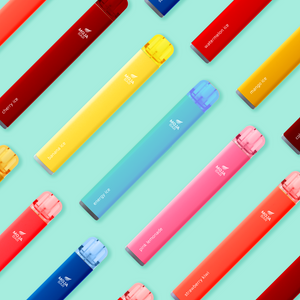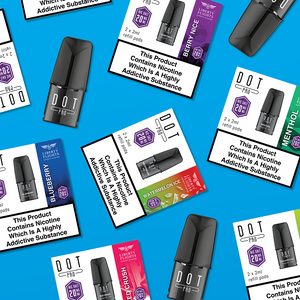
E-liquid Testing Results
Recent developments in the understanding of e-liquid safety and the effect of some of the flavour components have led to increased scrutiny across the industry with regards three key compounds. While these three compounds are used safely in food, special consideration must be given to inhalation use because the lungs are not equipped with the same level of defence mechanisms compared to the stomach i.e. when something is swallowed. This blog discusses these compounds of interest, why they need to be monitored and how Liberty Flights is ensuring the quality and safety of our e-liquids.
What is Diacetyl (DA)?
Diacetyl (or butane-2,3-dione) is an organic compound with the structure shown below:

It is classified as an alpha diketone (two C=O groups, side-by-side, ringed in red) and has an intense, buttery flavour. This means that it is often added to food as a flavouring agent but it can also occur naturally in alcoholic beverages.
What is Acetyl Propionyl (AP)?
Acetyl propionyl (or 2,3-pentanedione) is another alpha diketone with the structure illustrated below:

AP also has a buttery taste and can be found in food flavourings.
What is Acetoin?
Acetoin (or 3-hydroxybutanone), is a ketone (ringed in red), not a diketone like DA and AP, and has the structure shown below:

Acetoin is described as having a pleasant buttery odour, making it a popular food flavouring. It is also a chemical intermediate in the production of DA.
Why shouldn’t they be present in e-liquids?
During the use of DA as a flavouring for butter popcorn in the US, it was discovered that workers exposed to the flavouring during manufacture were at risk of Bronchiolitis obliterans (BO). BO is a rare and life-threatening form of non-reversible obstructive lung disease in which the bronchioles (small airway branches) are compressed and narrowed by fibrosis (scar tissue) and/or inflammation. After investigation, it was concluded that DA contributed to the damage caused and there is good data to support the presumption that both DA and AP are dangerous if inhaled (see links below). Evidence suggests the respiratory damage is linked specifically to the functional group of these molecules (an alpha diketone).
(1) http://www.cdc.gov/niosh/updates/upd-08-15-11.html
(2) http://tpx.sagepub.com/content/36/2/330.short
(3) http://tpx.sagepub.com/content/40/3/448.short
What is most concerning is that the maximum exposure limits for DA and AP are very low and it is vital that these compounds are tested for, at the lowest possible level, in any inhalation product. The recommended exposure limit (REL) for DA is 5 parts per billion (ppb) as an eight-hour, time-weighted average, (TWA) during a 40-hour work week. For AP the REL is 9.3 ppb(1).
This data has been applied to e-liquids by registered toxicologists (BIBRA Toxicology and Consulting) contracted by ECITA (Electronic Cigarette Industry Trade Association), who have set limits for DA and AP to 20 µg/ml in e-liquids, based on a daily consumption of no more than 3 ml of e-liquid per day. The possible inclusion of DA and AP, at any level, in some sweet tasting e-liquids is therefore a concern to the industry in general. According to the British Standards Institution (BSI) PAS 54115:2015 (Vaping products, including electronic cigarettes, e-liquids, e-shisha and directly-related products – Manufacture, importation, testing and labelling guide) these compounds are not permitted in the production of e-liquids.
Although not a diketone, there is conflicting evidence about the effect of acetoin on the body when inhaled. What is known is that it is a respiratory irritant and combined with the fact that it is an intermediate in the formation of DA, it has become a compound of concern. Bibra have quoted a safe level of 8400 µg/ml and Liberty Flights Ltd has chosen to test for and monitor acetoin levels as more data continues to become available.
Liberty Flights has taken the step of having our e-liquids tested at an independent, GMP laboratory to confirm that the level, if any, of DA, AP and acetoin are within acceptable, safe limits for inhalation.
How and where is the testing performed?
In order to get the highest quality, reputable data, Liberty Flights approached a well-known independent, GMP (Good Manufacturing Practice) laboratory and undertook extensive method development to create a method which had the highest possible level of sensitivity, despite the often complex mix of flavourings.
It was important to Liberty Flights to use an accredited laboratory that would perform the testing to the highest standard so selecting one with GMP approval was vital. GMP outlines the standard required in order to conform to legislation covering pharmaceutical manufacture and testing. As a result, standards are very high and ensure reputable, repeatable data is obtained.
Using an independent laboratory was also important to Liberty Flights, as we wanted the results to be unbiased, giving our customers confidence that the results were verified independently without interference from anyone invested in the outcome.
The method for detecting and quantifying DA, AP and acetoin uses High Performance Liquid Chromatography (HPLC). This approach separates compounds of interest from each other in the e-liquid. In HPLC, the sample is passed through a column (usually containing silica based packing), with a flowing solvent mixture through the system. Based on their structure, the individual components in the e-liquid sample have unique affinities for the packing material (i.e. silica) and the solvent mixture, and retain on the column for different periods of time relative to that affinity, before being eluted. This allows the different components to be detected as discreet peaks at different times by the detector.

Example of a HPLC chromatogram
(http://www.merckmillipore.com/GB/en/products/analytics-sample-prep/chromatography-for-analysis/analytical-hplc/aluspher-100-rp-select-b-hplc-columns/I36b.qB.kGEAAAE_sOR3.Lxi,nav).The concentration can then be calculated based on the intensity of the response to that compound in the detector (area under peak). This is a widely used analytical technique and the method development carried out by the laboratory ensured the limit of detection (LOD) and limit of quantification (LOQ) for the method was as low as possible whilst maintaining precision and specificity.
XO e-liquid test results

The certificates for the first 27 liquids tested can be found where you see the certificate symbol next to any flavour on the product pages. Due to the number of liquids available, this process is ongoing and as more results become available they will be published on the relevant product pages of our website.
For reference, 1 µg/ml equals 1 ppm and therefore, the safe limit of 20 µg/ml referenced previously equals 20 ppm for DA and AP and 8400 µg/ml equals 8400 ppm for Acetoin.
The limits of detection for the methods used to conduct this testing are 2 ppm. It can therefore be said that any e-liquids showing a result of ‘none detected’ (ND) have levels below 2 ppm and are therefore well within safe limits.
Liberty Flights is pleased that the results reflect the thorough approach taken to e-liquid quality.
Guest liquids
At Liberty Flights all of our guest e-liquid manufacturers are required to supply the appropriate certification on DA, AP and acetoin levels to ensure we only sell the best quality products. Please contact the manufacturer directly for more information.
A Final Note
Liberty Flights will continue to invest resources into scientific development to ensure that we produce e-liquid that is of the highest quality and is as safe as it can possibly be. If you have any questions about this blog, or anything else about Liberty Flights products, please feel free to get in touch via our customer service team or leave your comments below and we will do our very best to get back to you as soon as possible.
Lucy Robins
Chief Scientific Officer









